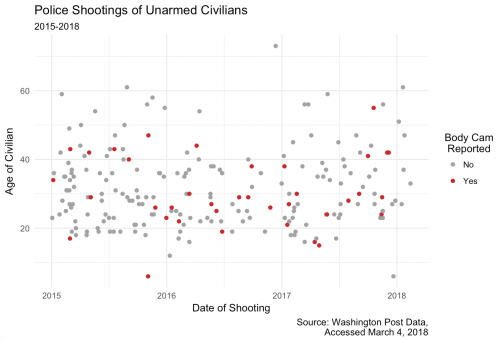The Washington Post has been collecting data on documented fatal police shootings of civilians since 2015, and they recently released an update to the data set with incidents through the beginning of 2018. Over at Sociology Toolbox, Todd Beer has a great summary of the data set and a number of charts on how these shootings break down by race.
One of the main policy reforms suggested to address this problem is body cameras—the idea being that video evidence will reduce the number of killings by monitoring police behavior. Of course, not all police departments implement these cameras and their impact may be quite small. One small way to address these problems is public visibility and pressure.
So, how often are body cameras incorporated into incident reporting? Not that often, it turns out. I looked at all the shootings of unarmed civilians in The Washington Post’s dataset, flagging the ones where news reports indicated a body camera was in use. The measure isn’t perfect, but it lends some important context.

Body cameras were only logged in 37 of 219 cases—about 17% of the time—and a log doesn’t necessarily mean the camera present was even recording. Sociologists know that organizations are often slow to implement new policies, and they don’t often just bend to public pressure. But there also hasn’t been a change in the reporting of body cameras, and this highlights another potential stumbling block as we track efforts for police reform.
Evan Stewart is an assistant professor of sociology at University of Massachusetts Boston. You can follow his work at his website, on Twitter, or on BlueSky.
Comments 7
Patrick Serna — March 7, 2018
Interesting subject and interesting article. Thank you, Sociological Images, for both.
--Martin Serna
Ria Chohan — June 17, 2021
Police has no right to target civilians no matter whatever they do under the law. I guess New York state need police reforms in order to avoid this sort of events in the future. I am glad to see all those police officers behind the bars who were involved in police shooting in New York. I have been thinking to visit https://www.stephilareine.com/2021/03/5-tips-for-writing-a-fashion-research-paper.html to read tips for fashion research paper to complete it on time.
see the requirement – Kijiji Tutorr — January 3, 2022
[…] https://thesocietypages.org/socimages/2018/03/05/are-we-really-looking-at-body-cameras/ (Links to an… […]
jason bevis — July 7, 2022
drift hunters is an impressive game to play in 2022. Hurry up to play to experience the fun of this game.
). short blogthe society pages blog H u m a n i t i e s - EssayGuruPro — August 18, 2022
[…] https://thesocietypages.org/socimages/2018/03/05/are-we-really-looking-at-body-cameras/ (Links to an… […]
abel — April 7, 2023
I have been suffering from sumplete unlimited depression for a long time and I have been having trouble finding the right therapist.
orabelle hana — January 19, 2024
I think it's possible moto x3m bike race game